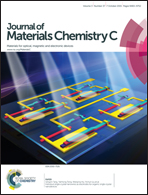Electronic and transport properties of porous graphene sheets and nanoribbons: benzo-CMPs and BN codoped derivatives†
Abstract
We investigate the electronic and electron transport properties of a series of 2D porous n-benzo-CMP (CMP refers to π-conjugated microporous polymer) sheets with different pore sizes n and their boron-nitride (BN) codoped derivatives, BN-n-benzo-CMPs, as well as one-dimensional (1D) porous graphene nanoribbons (p-GNRs) tailored from n-benzo-CMPs and BN-n-benzo-CMPs using density-functional theory (DFT) and the non-equilibrium Green's function (NEGF) methods. We find that the n-benzo-CMP and BN-n-benzo-CMP (n = 3, 4, 5) sheets are all semiconductors with direct band gaps (0.57–1.75 eV). Their band gap decreases with increasing pore size n. In addition, the 1D armchair and zigzag p-GNRs tailored from 2D n-benzo-CMP and BN-n-benzo-CMP (n = 3, 4, 5) sheets are all semiconductors with their band gaps ranging from 0.19 to 2.0 eV. BN codoping, pore size (n), and the width of nanoribbons (w) can all be used to tune the band gap of either 2D porous graphenes or their corresponding 1D p-GNRs. Computed current–voltage (I–Vb) curves are consistent with the semiconducting properties and suggest that both BN-3-benzo-CMPs and BN-p-3ZGNRs (w = 4) can be exploited for applications in low-dimensional electronics.


 Please wait while we load your content...
Please wait while we load your content...